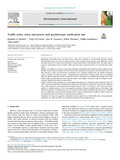Traffic noise, noise annoyance and psychotropic medication use

Files
Self archived version
published versionDate
2018Author(s)
Unique identifier
10.1016/j.envint.2018.06.034Metadata
Show full item recordMore information
Self-archived item
Citation
Okokon, EO. Yli-Tuomi, T. Turunen, AW. Tiittanen, P. Juutilainen, J. Lanki, T. (2018). Traffic noise, noise annoyance and psychotropic medication use. ENVIRONMENT INTERNATIONAL, 119, 287-294. 10.1016/j.envint.2018.06.034.Rights
Abstract
Background
Road-traffic noise can induce stress, which may contribute to mental health disorders. Mental health problems have not received much attention in noise research. People perceive noise differently, which may affect the extent to which noise contributes to poor mental health at the individual level. This paper aims to assess the relationships between outdoor traffic noise and noise annoyance and the use of psychotropic medication.
Methods
We conducted a survey to assess noise annoyance and psychotropic medication among residents of the Helsinki Capital Region of Finland. We also assessed the associations of annoyance and road-traffic noise with sleep disorders, anxiety and depression. Respondents were randomly sampled from the Finnish Population registry, and data was collected using a self-administered questionnaire. Outdoor traffic noise was modelled using the Nordic prediction model. Associations between annoyance and modelled façade-noise levels with mental health outcome indicators were assessed using a binary logistic regression while controlling for socioeconomic, lifestyle and exposure-related factors.
Results
A total of 7321 respondents returned completed questionnaires. Among the study respondents, 15%, 7% and 7% used sleep medication, anxiolytic and antidepressant medications, respectively, in the year preceding the study. Noise annoyance was associated with anxiolytic drug use, OR = 1.41 (95% CI: 1.02–1.95), but not with sedative or antidepressant use. There was suggestive association between modelled noise at levels higher than 60 dB and anxiolytic or antidepressant use. In respondents whose bedroom windows faced the street, modelled noise was definitively associated with antidepressant use. Noise sensitivity did not modify the effect of noise but was associated with an increased use of psychotropic medication.
Conclusion
We observed suggestive associations between high levels of road-traffic noise and psychotropic medication use. Noise sensitivity was associated with psychotropic medication use.


